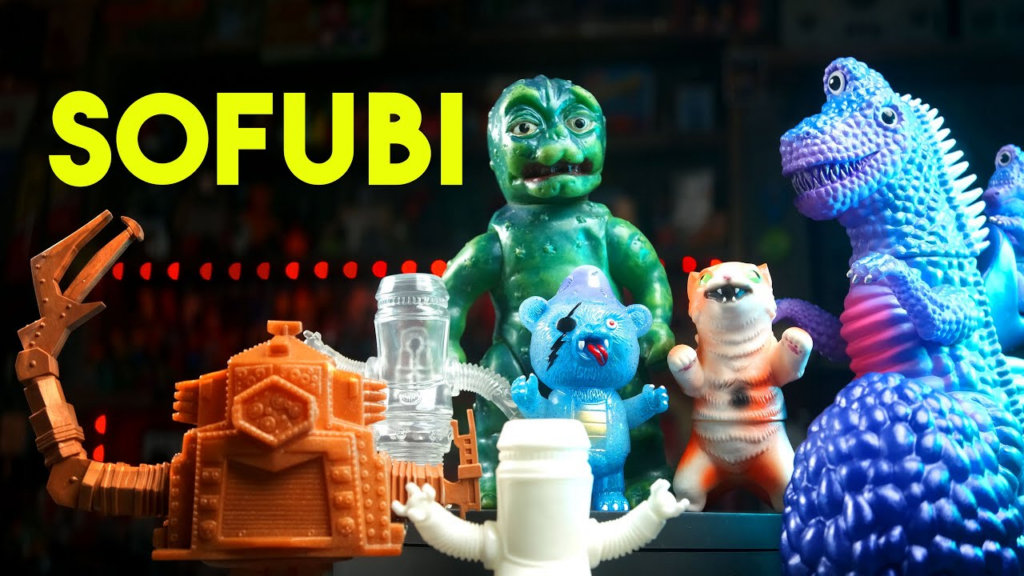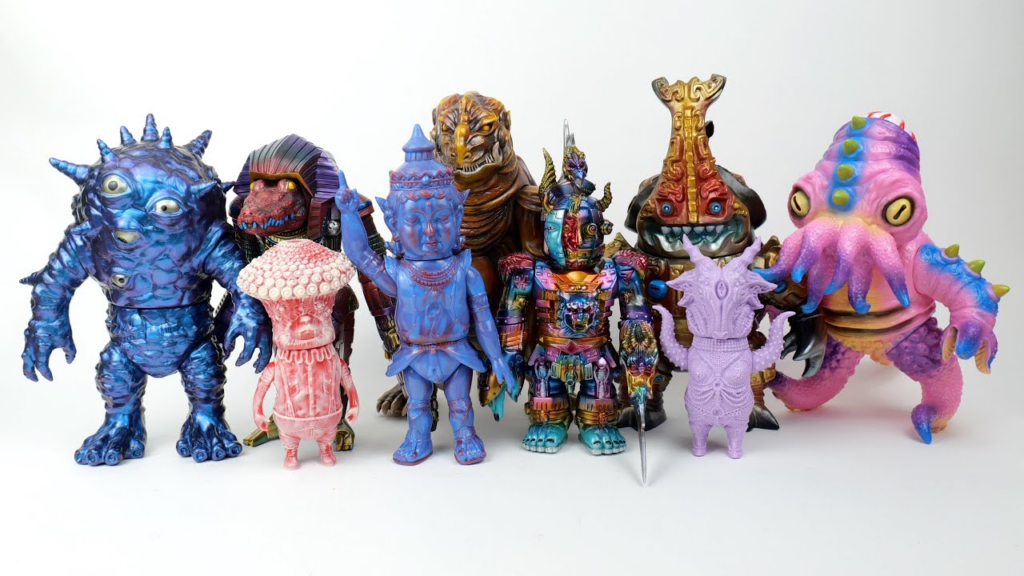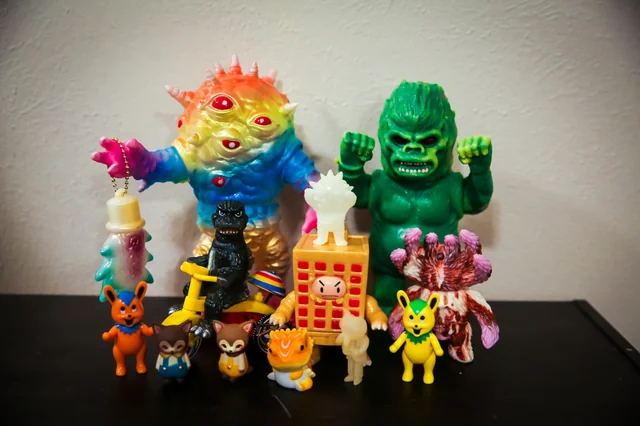In the world of toy collecting in Japan, there is a unique category that has captured the hearts of collectors with its rarity and distinctive design. Imagine Ultraman, Godzilla, Gundam warriors, Mazinger Z, and the brave Voltes V – these iconic Japanese franchises, much more than just on-screen heroes, are transformed into meticulously crafted toys, becoming superstars in collectors’ showcases. This is where Sofubi comes into play, with its inimitable charm, adding a touch of originality and surprise to the world of toys.

These little marvels are toys made from soft vinyl, a material used to create figurines based on classic Japanese monsters, superheroes, folk legends, and pop culture icons. The history of Sofubi dates back to the 1950s when these soft vinyl toys began to emerge in Japan, with designs and production techniques that were already ahead of their time. Today, Sofubi has become a true treasure in the world of collecting: each piece is a work of art, whether it is created by independent artists or produced by the biggest companies, and they are becoming increasingly rare, making each toy a precious item.
This article will serve as your guide to uncovering all the secrets of Sofubi: from their essence and craftsmanship to the stories of their creators and where to find them. Together, we’ll dive into the fascinating history of their creation, revisit the glorious moments of their first appearances, and explore their evolution into the captivating and timeless forms they take today.
Sofubi (ソフビ), or Japanese soft vinyl figures, derive their name from an ingenious blend of the Japanese words for “soft” (ソフト, sofuto) and “vinyl” (ビニル, biniru). Literally translating to “soft vinyl,” they are also known as sofvi or soft vinyl toys, and in China, they’re commonly referred to as “soft vinyl figures.”
Sofubi possess a unique charm, nostalgically evoking the retro Japanese aesthetic of the 1960s to 1980s. They harken back to vintage toys inspired by monsters and characters from tokusatsu—the genre of special effects films and series.

Today, Sofubi often stand out with original designs deeply rooted in traditional Japanese culture, including folklore passed down through generations. Others embrace psychedelic styles, making them especially eye-catching within the realm of collectible art.
Unlike mass-produced toys manufactured on automated production lines, each piece of Sofubi is meticulously handcrafted by skilled artisans. This artisanal process elevates them into true works of art. Sofubi capture and convey an artist’s creative vision in three-dimensional form, rendering each figure an invaluable treasure for collectors worldwide.

Modern Sofubi figures are meticulously crafted by independent artists and renowned Japanese toy manufacturers. Sometimes, these creators collaborate with Sofubi makers to design truly unique and limited-edition pieces, making each creation especially valuable in the eyes of collectors.
Due to the intricate manufacturing process and the fact that Sofubi is not mass-produced, these figures are typically released in limited quantities, often in small runs. Even when a large company releases a Sofubi, it is frequently sold out as soon as it goes on sale. This is why Sofubi, as a handcrafted Japanese product, enjoys exceptional popularity and allure among collectors worldwide.
Japan, a pioneer in technological innovation, is also the birthplace of soft vinyl toys. As early as the 1950s, Japanese toy manufacturers embarked on a material revolution by experimenting with soft vinyl (Sofubi). Their goal was to surpass the popular celluloid toys of the time by creating toys that were both more durable and accessible.
In the 1960s, as Godzilla became a cultural icon of Japan, a wave of monsters swept across the country. Soft vinyl toys, with their ability to capture both the robustness and delicacy of these creatures, quickly became stars in the toy market.

As the 1970s and 1980s rolled in, the tokusatsu genre (Japanese special effects films and series) experienced an explosion, with the rise of superheroes like Kamen Rider and Ultraman, propelling Sofubi figures to new heights.
Originally, Sofubi figures were primarily designed as export toys for the United States, contributing to Japan’s post-war reconstruction. They quickly captured the global market, gaining international recognition. However, with the outsourcing of production by Japanese companies, Sofubi’s popularity began to wane over time.
Nevertheless, in the 1990s, with the rise of Japanese urban culture, Sofubi experienced a renaissance. Fashion brands like Beams began to reissue Ultraman figures, bringing these icons back into the spotlight.

At the same time, independent artists started creating custom hand-made Sofubi, giving rise to a new era of design. Today, whether from major companies like Medicom Toy and Max Toy or talented independent artists, all continue to write the Sofubi legend in their own way, keeping this tradition alive in an ever-evolving world of collecting.
Compared to other collectible figures, the process of creating a Sofubi is far more complex and refined. Each Sofubi begins with the original sketch of an independent artist.

Whether they draw by hand or use digital tools, artists transform their ideas into living characters. Once the sketch is complete, it is skillfully converted into a 3D model, which will serve as the base for creating a wax prototype. This wax model represents the initial stage of manufacturing and sets the foundation for the next steps in the process.
The wax model is then melted down and transformed into a hollow metal mold through a process called electroplating. This metal mold is crucial for creating copies of the final product. The next step involves using this metal mold to pour liquid vinyl inside, a technique known as rotomolding. This process gives the Sofubi its unique shape and intricate details.
Rotomolding allows for the recreation of complex, detailed shapes, giving each figure a lifelike dimension. Finally, the Sofubi is painted using various coloring techniques, which give it its vibrant skin tone and striking appearance.

This process not only requires specialized equipment but also highly skilled artisans trained to master the craft of Sofubi creation. As a result, each figure is a work of art produced in limited quantities, making them even more precious to collectors. The Sofubi is not a mass-produced item; it is the product of meticulous craftsmanship and undeniable passion.
The charm of Sofubi lies in their very essence: more than mere toys, they are cultural artifacts, nostalgic time capsules, and true works of art. These vintage toys, infused with the aura of the past, seem to wield a magical power that transports us back to childhood—an age of innocence and boundless dreams.
As previously mentioned, Japan was once the artisanal cradle of Sofubi, crafted with traditional techniques. However, as manufacturing shifted overseas for industrial-scale production, these toys—integral to so many childhood memories—became increasingly scarce. Yet, like a long-lost friend, Sofubi has re-emerged into the spotlight, revitalized by daring designs and richer color palettes.

According to Manami Okazaki, a journalist for Tokyo Weekend, artists like Takeo draw inspiration from their childhood memories, populated by heroes such as Ultraman and Godzilla, to create Sofubi. For these creators, these toys become powerful conduits of nostalgia, reigniting the moments of wonder from their youth and enabling their artistry to transcend time.
Another key factor behind the success of Sofubi lies in their rarity. Due to their complex manufacturing process, some series are limited to only ten to twenty pieces. This scarcity makes them highly coveted, sparking a frenzy among collectors who relish the challenge and excitement of tracking down these unique items.
Sofubi has now become a cornerstone of toy culture. Thanks to dynamic interactions within collector communities, particularly through social media and toy conventions, the Sofubi culture has experienced an unprecedented boom.

For Teresa Chiba, a well-known Sofubi artist, the appeal of these toys lies in their artisanal nature: “Sofubi are like traditional Japanese toys. They have an ‘artisanal warmth,’ created by hand by craftsmen, not by machines in factories.”
At its core, owning a Sofubi means possessing a unique work of art. It’s not just a toy; it’s a piece of history, a narrative, and a precious memory, passed down from generation to generation.
#OneMallJapan #JapaneseCollectibles #BuyFromJapan #JapanShopping #ShopJapanese
